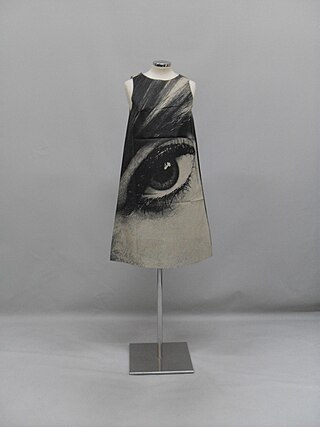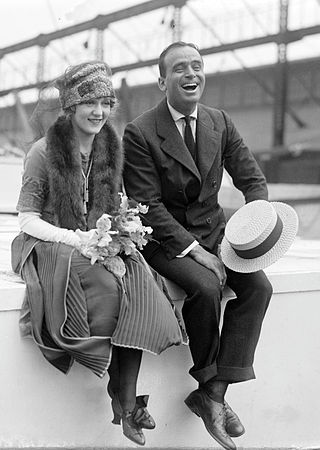
Black tie is a semi-formal Western dress code for evening events, originating in British and North American conventions for attire in the 19th century. In British English, the dress code is often referred to synecdochically by its principal element for men, the dinner suit or dinner jacket. In American English, the equivalent term tuxedo is common. The dinner suit is a black, midnight blue or white two- or three-piece suit, distinguished by satin or grosgrain jacket lapels and similar stripes along the outseam of the trousers. It is worn with a white dress shirt with standing or turndown collar and link cuffs, a black bow tie, typically an evening waistcoat or a cummerbund, and black patent leather dress shoes or court pumps. Accessories may include a semi-formal homburg, bowler, or boater hat. For women, an evening gown or other fashionable evening attire may be worn.

Yves Henri Donat Mathieu-Saint-Laurent, referred to as Yves Saint Laurent or YSL, was a French fashion designer who, in 1962, founded his eponymous fashion label. He is regarded as being among the foremost fashion designers of the twentieth century. In 1985, Caroline Milbank wrote, "The most consistently celebrated and influential designer of the past twenty-five years, Yves Saint Laurent can be credited with both spurring the couture's rise from its 1960s ashes and with finally rendering ready-to-wear reputable."

A miniskirt is a skirt with its hemline well above the knees, generally at mid-thigh level, normally no longer than 10 cm (4 in) below the buttocks; and a dress with such a hemline is called a minidress or a miniskirt dress. A micro-miniskirt or microskirt is a miniskirt with its hemline at the upper thigh, at or just below crotch or underwear level.

Count Hubert James Marcel Taffin de Givenchy was a French aristocrat and fashion designer who founded the luxury fashion and perfume house of Givenchy in 1952. He is famous for having designed much of the personal and professional wardrobe of Audrey Hepburn and clothing for Jacqueline Bouvier Kennedy. He was named to the International Best Dressed List Hall of Fame in 1970.

Niki de Saint Phalle was a French-American sculptor, painter, filmmaker, and author of colorful hand-illustrated books. Widely noted as one of the few female monumental sculptors, Saint Phalle was also known for her social commitment and work.
Betty Catroux is a Brazilian-born French former Chanel model, and fashion icon. She has been cited as a muse by both Yves Saint Laurent and Tom Ford.

Youthquake was a 1960s cultural movement. The term was coined by Vogue magazine's editor-in-chief Diana Vreeland in 1965. Youthquake involved music and pop culture, and it changed the landscape of the fashion industry. The movement is characterized by looking to youth culture for a source of inspiration, taking dominance away from the English and Parisian couture houses.

Fashion in the 1990s was defined by a return to minimalist fashion, in contrast to the more elaborate and flashy trends of the 1980s. One notable shift was the mainstream adoption of tattoos, body piercings aside from ear piercing and, to a much lesser extent, other forms of body modification such as branding.

Emanuel Ungaro was a French fashion designer who founded the fashion house called the House of Emanuel Ungaro in 1965.

A pantsuit, also known as a trouser suit outside the United States, is a woman's suit of clothing consisting of pants and a matching or coordinating coat or jacket.

Fashion of the 1980s was characterized by a rejection of 1970s fashion. Punk fashion began as a reaction against both the hippie movement of the past decades and the materialist values of the current decade. The first half of the decade was relatively tame in comparison to the second half, which was when apparel became very bright and vivid in appearance.

Fashion of the 1960s featured a number of diverse trends, as part of a decade that broke many fashion traditions, adopted new cultures, and launched a new age of social movements. Around the middle of the decade, fashions arising from small pockets of young people in a few urban centers received large amounts of media publicity, and began to heavily influence both the haute couture of elite designers and the mass-market manufacturers. Examples include the mini skirt, culottes, go-go boots, and more experimental fashions, less often seen on the street, such as curved PVC dresses and other PVC clothes.

Fashion in the 1970s was about individuality. In the early 1970s, Vogue proclaimed "There are no rules in the fashion game now" due to overproduction flooding the market with cheap synthetic clothing. Common items included mini skirts, bell-bottoms popularized by hippies, vintage clothing from the 1950s and earlier, and the androgynous glam rock and disco styles that introduced platform shoes, bright colors, glitter, and satin.

Western fashion in the 1920s underwent a modernization. For women, fashion had continued to change away from the extravagant and restrictive styles of the Victorian and Edwardian periods, and towards looser clothing which revealed more of the arms and legs, that had begun at least a decade prior with the rising of hemlines to the ankle and the movement from the S-bend corset to the columnar silhouette of the 1910s. Men also began to wear less formal daily attire and athletic clothing or 'Sportswear' became a part of mainstream fashion for the first time.

Yves Saint Laurent SAS, also known as Saint Laurent and YSL, is a French luxury fashion house founded in 1962 by Yves Saint Laurent and his partner, Pierre Bergé. The company specializes in haute couture, ready-to-wear, leather accessories, and footwear. Its cosmetics line, YSL Beauty, is owned by L'Oréal.

Grunge fashion refers to the clothing, accessories and hairstyles of the grunge music genre. This subculture emerged in mid-1980s Seattle, and had reached wide popularity by the mid 1990s. Grunge fashion is characterized by durable and timeless thrift-store clothing, often worn in a loose, androgynous manner to de-emphasize the silhouette. The style was popularized by music bands Nirvana, Soundgarden and Pearl Jam.

Vera Borea is a French fashion house founded in 1931 in Paris, France, by Countess Borea de Buzzaccarini Regoli.

A fashion boot is a boot worn for reasons of style or fashion. The term is usually applied to women's boots. Fashion boots come in a wide variety of styles, from ankle to thigh-length, and are used for casual, formal, and business attire. Although boots were a popular style of women's footwear in the 19th century, they were not recognized as a high fashion item until the 1960s. They became widely popular in the 1970s and have remained a staple of women's winter wardrobes since then.

The 2010s were defined by hipster fashion, athleisure, a revival of austerity-era period pieces and alternative fashions, swag-inspired outfits, 1980s-style neon streetwear, and unisex 1990s-style elements influenced by grunge and skater fashions. The later years of the decade witnessed the growing importance in the western world of social media influencers paid to promote fast fashion brands on Pinterest and Instagram.
Social standards typically restrict people's dress according to gender. Trousers were traditionally a male form of dress, frowned upon for women. However, during the 1800s, female spies were introduced, and Vivandières wore a certain uniform with a dress over trousers. Women activists during that time would also decide to wear trousers; for example, Luisa Capetillo, a women's rights activist and the first woman in Puerto Rico to wear trousers in public.


















